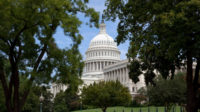The $825-billion economic stimulus proposal that House Democrats unveiled yesterday provides the first solid numbers for those in the design and construction industry who have been searching anxiously for hints about the plan.
Infrastructure advocates panned the proposal as far short of what is needed. But with House committee and floor votes and Senate action still to come, the package is far from the last word on the stimulus.
As drafted, the plan calls for roughly $550 billion in spending and $275 billion in tax cuts over two years. The plan would have a major impact on construction: By Engineering News-Record’s calculation, about $135 billion of the spending portion of the plan would go toward construction. Additionally, construction firms would benefit from the plan’s tax incentives, which includes an extension of a provision that allows small companies to write off the costs of equipment and other capital purchases in the year those items are purchased.
One of the largest allocations in the package is $20 billion for upgrading educational facilities, including $14 billion for repairs to K-12 schools and $6 billion for higher education (community colleges, colleges, and universities). The plan also would provide $7.7 billion to the General Services Administration for construction, repairs, and operations of federal buildings. Of the $7.7 billion, $6 billion would go toward boosting energy conservation and energy efficiency in federal buildings.
President-elect Barack Obama, whose advisors worked with key lawmakers in designing the proposal, welcomed the House Democrats’ bill, calling it “a significant down payment on our most urgent challenges.”
The House package drew qualified support from the American Institute of Architects (AIA), which released its own stimulus recommendations earlier this week. “We have proposed higher funding levels, but as a first draft, it is encouraging,” says Andrew Goldberg, the organization’s senior director of federal affairs. The group is lobbying for legislation that includes money for projects that are still in initial design phases. And, although the House proposal gives preference to “quick-start” work, its language does also allow for financing of longer-term projects, points out Goldberg. “‘Shovel ready’ shouldn’t be the only criteria.”
While the AIA is optimistic, the proposal drew quick and sharp criticism from some infrastructure advocates, who contend that it short-changes key public-works sectors.
“Any step forward is progress,” says Terence M. O’Sullivan, general president of the laborers’ union, “but this level of investment falls far short of needs and fails to fully take advantage of the opportunity to put America back to work building the essential and long-neglected basics of our country.”
Rep. Peter DeFazio (D.Ore.), a senior Transportation and Infrastructure Committee member, says that by his calculation, “real infrastructure investment” would account for about 7.5 percent of the package, a level that he says is inadequate. DeFazio appeared to be referring to the $63 billion in the plan that would go to highways, transit, airports and other infrastructure programs under the transportation committee's jurisdiction. Committee Chairman James Oberstar (D-Minn.) had proposed about $85 billion for those programs.
DeFazio suggested that the committee consider sending a letter or a resolution to House Democratic leaders, saying that “we need a much more substantial number on proven needs for projects that can put people to work and make our transportation more effective.”
House Speaker Nancy Pelosi (D-Calif.) says party leaders are “excited” about the proposal, but cautions that “this is the first step along the way.” She says three major House committees—Appropriations, Ways and Means, and Energy and Commerce—would vote on their portions of the legislation the week of January 19. Pelosi says a floor vote would take place the following week.
The measure then would go to the Senate. Pelosi says that House and Senate Democrats have “shared values” and “shared priorities,” but the Senate may well modify the House Democrats’ plan. “We try to minimize the differences going in,” Pelosi says, “but I would be surprised—and I am rarely surprised—if [House and Senate plans] would be identical.”
Appropriations Committee Chairman David Obey (D-Wisc.), who was in charge of drafting the $550-billion spending portion, says, “What it is, is simply the largest effort by any legislative body on the planet to try to take government action to prevent economic catastrophe.” But Obey adds that even such a large package “may be insufficient” to meet that goal. “We may need to do even more at a later date.”
Joann Gonchar, a senior editor at Architectural Record, contributed additional reporting for this story.
Read more economic coverage in our special section, Recession Reports.




Post a comment to this article
Report Abusive Comment